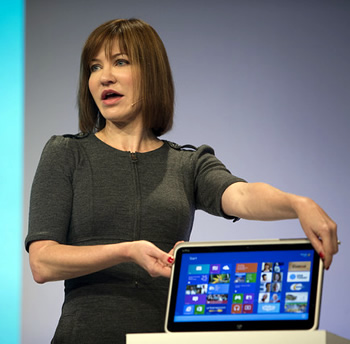Taking over after Sinofsky's departure, Julie Larson-Green now heads Microsoft's Windows product development team. In an interview with MIT Technology Review, Larson-Green discusses some of the changes made to Windows and why with the company's latest operating system.
We already know that Windows' neo-classical Start menu fell prey to telemetry data – the often steely-cold serial murderer of withering features and prognosticator of otherwise seemingly arbitrary changes. But Larson-Green explains the true value of the Metro Start Screen is seeing everything you care about in a quick glance.
But with Windows 8, all the different things that you might want to do are there at a glance with the Live Tiles. Instead of having to find many little rocks to look underneath, you see a kind of dashboard of everything that's going on and everything you care about all at once. It puts you closer to what you're trying to get done.
Source: technologyreview.com, Julie Larson-Green
While TechSpot staffers seem to mostly agree the loud, vitriolic contempt for the Metro Start screen has been largely over-blown, its controversy isn't without reasonable merit.
One point of contention with Windows 8's Start menu-replacement is its lack of "cohesiveness" with the Windows desktop. Larson-Green admits their differences, but indicates the Metro Start Screen provides a way for users to have their cake and eat it too. "It was a very definite choice to have both environments." she told the interviewer, "We didn't want you to have to make a choice." She goes on to say that some people found it jarring at first, but those individuals have since grown accustomed to it.
When asked about Windows 8's ostensible focus on touch, Larson-Green seems to firmly believe touch is the future. Touch is the most direct and natural way to interact with computers, indicates the Windows executive. She envisions a future where virtually all devices (including PCs) are touch-enabled.

I feel obligated here to mention what an ergonomic nightmare touch-enabled PCs represent, but I won't deny that having the option isn't appealing (or even the future of everything). The thought of relying solely on touch though, well, that's a difficult future to swallow from an at-your-desk usability perspective. Larson-Green does acknowledge that a finger will never be as precise as a mouse and that an on-screen keyboard will never beat a real one – but she does believe people will get used to working with their fingers instead.
Microsoft has been watching groups of people over a series of months using Windows 8 under a program called "Living with Windows". When asked how people are reacting, Larson-Green responded, "So far we're seeing very encouraging things." She added, "Over 90 percent of customers, from our data, use the charms and find the start screen all in the first session. Even if you're a desktop user, over time there's a cutover point around six weeks where you start using the new things more than the things you're familiar with."
Read the entire interview here.
